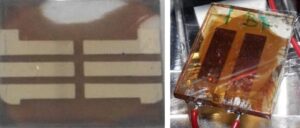What are Perovskite Solar Cells
and how are they made?
and how are they made?
Introduction
With the ever increasing demand for green energy, such as solar energy, the need for high efficiency photovoltaics has increased significantly. Currently, perovskite solar cells are showing impressive rates of performance compared to other photovoltaics technology. As of today, perovskites have reached power conversion efficiencies of about 25%, with further increase of efficiencies predicted. Another advantages of perovskites are, the straightforward production and the usage in flexible and low-weight devices. Commercialization of these perovskites are now underway, as well as the optimization of their performance.
Definitions of perovskite materials vary, but they all have the same general formula ABX3, where A and B are cations and X is an anion. Typically, B is a metal cation and X is a halide. Cation A can be either organic or inorganic. Another important feature is the geometry, the perovskite material must be arranged in a specific geometry: BX6 octahedra intercalated with A cations. A visual depiction of this is below:

The perovskite material is the light-harvesting substance in PSCs. For this, it absorbs photons that results in electron-hole pair formation. Later, this electron-hole pair may separate (or not, though loss mechanisms underlying solar cell inefficiencies), leading to the release of negative and positive charge carriers. These electron (negative) and hole (positive) charge carriers are collected, separately, by other materials in the device (transport layers) and flow out to generate a voltage in an external circuit.’
Various perovskite materials have been investigated for PSCs, with the most common being MAPbI3.This material consists of methylammonium+ cations intercalating an octahedral framework of Pb2+ cations and iodide (I–) anions.

Methods for making PSCs fall into two distinct categories: solution-based and vacuum evaporation.
Solution based approaches, using techniques such as spin-coating, are quick, involve low-cost equipment, give well-performing devices and are quick to establish in the laboratory. However, they are not scalable and therefore poorly-suited to industrial-scale production.
On the other hand, vacuum evaporation (a class of physical vapour deposition—PVD), involves heating perovskite precursors in a vacuum chamber such that they evaporate upwards to coat a substrate. With careful control of the process, the precursors combine to form the required perovskite material. Evaporation approaches also provide excellent results, are compatible with other processes required during solar cell fabrication (e.g., deposition of transport layers and metal contacts—also often done using PVD), and are scalable.
Click the button ‘request application note’ and download the full application note